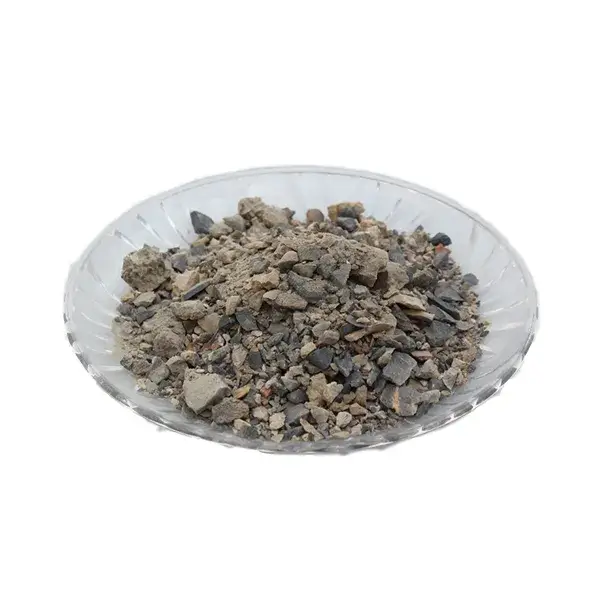The composition and microstructure of the binder system determine the performance of refractory castables. The development history of refractory castables is also the history of binder evolution. Figure 1 illustrates the progression of unshaped refractory castables from cement-bonded to low-cement-bonded, ultra-low-cement-bonded, and cement-free bonding systems.
Calcium aluminate cement
The cementitious binder in refractory castables typically refers to calcium aluminate cement, whose main components are calcium aluminate (CA) and calcium dialuminate (CA₂). These react with water at room temperature to form hydrated binding phases that provide early-stage bonding strength. Cement-bonded refractory castables may exhibit cracking during the drying and dehydration process. The high CaO content in calcium aluminate cement readily reacts with SiO₂ components in the material or slag constituents to form low-melting phases, degrading the high-temperature performance of the refractory castable. Additionally, high-temperature heat treatment of the cement generates CA₂ and CA₆ phases, both causing significant volume expansion that leads to structural loosening. To enhance the high-temperature properties of castables and reduce CaO introduction, the use of calcium aluminate cement in castables has been progressively reduced.
Non-Cementitious Binders Non-cementitious binders encompass chemical binders, hydrated alumina (ρ-Al₂O₃), micropowders, and nano-binders. Common chemical binders like aluminum dihydrogen phosphate, sodium polymer phosphate, and water glass are relatively low-cost. However, chemical binders typically suffer from high-temperature decomposition or introduce salt impurities, both of which impair the material’s high-temperature performance. In contrast, the latter three types of binders remain composed of oxides, similar to the main components of the material. They do not introduce additional impurities and may even react with other components to form new binding phases.
ρ-Al₂O₃ is the only form of aluminum oxide among various crystalline structures that can react with water at room temperature. Similar to cementitious binders, ρ-Al₂O₃ exhibits a hydration-based bonding mechanism. Reacting with water, ρ-Al₂O₃ forms gibbsite (aluminum trihydrate) and boehmite (aluminum monohydrate) gels. As these hydration products grow, they interconnect adjacent aggregates and the matrix, thereby providing green strength to the castable green body. The introduction of ρ-Al₂O₃ binders eliminates the issue of calcium-containing low-melting phases in cement-bonded castables, correspondingly improving high-temperature properties such as flexural strength, load-bearing softening temperature, and slag resistance. Furthermore, ρ-Al₂O₃ reduces the material’s linear expansion compared to cementitious binders, primarily due to its superior sintering properties. However, ρ-Al₂O₃ binders also present limitations. First, their small particle size and large specific surface area decrease the castable’s flowability, drastically increasing the required mixing water content and compromising workability. Second, the gel products formed during ρ-Al₂O₃ hydration densely fill the internal voids of the castable. Consequently, ρ-Al₂O₃-bonded castables exhibit low permeability, cannot withstand rapid drying, and demonstrate poor resistance to cracking.
Micro powder
The incorporation of micropowders or submicron powders as binders in castable compositions serves dual purposes: first, to fill voids between coarse particles with minimal water addition, thereby enhancing bulk density and improving flowability; second, to react with water to form hydrated binding phases, whose bonding mechanism resembles cohesive bonding. Investigating the hydration behavior of micropowders in castables has become the mainstream approach for developing novel hydration-based binding systems worldwide. Commonly used microspheres in castables include SiO₂ microspheres, Al₂O₃ microspheres, and MgO microspheres.
SiO₂ microspheres dissolve in water, carrying a high anionic charge (Si-O⁻) on their surfaces. Mg²⁺ and Ca²⁺ ions in the medium act as cementing agents, connecting SiO₂ particles to form a network flocculation structure that provides material bonding strength. The Microsilica-Gel bonding model integrates both silica sol and microsilica bonding mechanisms. This Microsilica-Gel binder retains the advantages of silica sol bonding while preserving the flow-enhancing properties of spherical microsilica. Concurrently, a small amount of calcium aluminate cement (less than 0.5 wt%) must be used in combination. This is because Ca²⁺ ions generated through cement hydrolysis can interconnect SiO₂ micropowder particles to form Si-O-Si bonds, thereby generating bonding strength. Beyond ρ-Al₂O₃ micropowder’s hydration-based bonding properties, other ultrafine powders like α-Al₂O₃ micropowder and corundum micropowder are incorporated into castables primarily to form ceramic phases during medium-to-high-temperature firing, thereby enhancing bonding strength. Recent studies indicate that α-Al₂O₃ micropowder can influence the hydration behavior of calcium aluminate cement binders. Commercial calcium aluminate cement exhibits a decrease in hydration rate with increasing temperature within the 10-30°C range, a phenomenon termed anomalous hydration behavior that prolongs setting time. In the presence of alumina micropowder, the formation of the lamellar C2AH8 phase is promoted at 20-30°C. This phase facilitates water penetration through interlayer gaps to contact unhydrated cement particles, enabling continued hydration and eliminating the anomalous hydration behavior.
Research on magnesium oxide micropowder as a hydration binder focuses on two aspects: First, the hydration of magnesium oxide to form magnesium hydroxide provides bonding strength. For instance, organic acid additives promote the hydration of active magnesium oxide, rapidly generating magnesium hydroxide crystal nuclei, controlling the morphology of magnesium hydroxide, reducing apparent porosity, and enhancing the early strength of aluminum-magnesium castables. Second, magnesium oxide undergoes hydration reactions with ρ-Al₂O₃ or SiO₂ micropowders within the castable, forming third-phase hydration products. Magnesium oxide micropowder influences the medium-to-high temperature properties of the castable. Braulio’s research indicates that larger particle sizes of magnesium oxide powder slow Mg²⁺ diffusion, inhibiting the in-situ formation of spinel within calcium aluminate cement-bonded alumina-magnesium castables. Simultaneously, this promotes the reaction between alumina and calcium oxide to form CA₆, exacerbating the material’s linear expansion and creep while reducing slag resistance. Conversely, compared to smaller (<45 μm) magnesia micropowders, larger (<100 μm) magnesia micropowders promote the formation of magnesian olivine and CA6. Both possess higher thermal expansion coefficients than spinel and corundum. Their mismatch with the matrix material induces microcracks, thereby enhancing thermal shock stability.
In recent years, increasing research has focused on composite powder binders. Professor Szczerba’s group in Poland compared the hydration processes and product compositions of four slurries—MgO-SiO₂, MgO-Al₂O₃-SiO₂, Al₂O₃-SiO₂, and MgO-Al₂O₃-SiO₂—under varying temperatures and water-to-cement ratios. Al₂O₃-SiO₂, and MgO-Al₂O₃-SiO₂ slurries under varying temperatures and water-to-cement ratios. Results indicate that MgO-SiO₂ slurry produced magnesium hydroxide and magnesium silicate hydrate (M-S-H), MgO-Al₂O₃ slurry yielded magnesium hydroxide and magnesium aluminate hydrate (M-A-H), while MgO-Al₂O₃-SiO₂ slurry generated amorphous colloidal products in addition to magnesium hydroxide. In contrast, the Al₂O₃-SiO₂ slurry exhibited no significant exothermic hydration reaction during the process, and no new hydration phases were detected in the product analysis.
Nano powders
With the advancement of nanotechnology, sol-gel and nano-powders have been introduced as binders in castables. Nanomaterials feature particle sizes at the nanoscale, exhibiting large specific surface areas and high reactivity. They can form high-temperature ceramic phases with other constituents at lower temperatures, enhancing material strength and density. However, severe agglomeration occurs in nano-powders. If dispersion issues are resolved, adding nano-powders can improve the microstructure and performance of castables. Research indicates that sol-gel bonded high-alumina castables exhibit lower apparent viscosity than cement-bonded castables, with sol-gel providing superior workability. Sol-gel binders also inherit characteristics of zeolite minerals, featuring a broad dehydration temperature range. During dehydration, they do not negatively impact material bonding strength but instead enhance structural stability, overcoming the temperature sensitivity of cement-bonded materials. Furthermore, their chemical composition aligns closely with the primary constituents of the material, introducing minimal harmful impurities and enhancing the high-temperature performance of the castable. Sol-gel bonded castables exhibit superior permeability compared to cement and ρ-Al₂O₃ binders, facilitating efficient moisture dissipation during drying. This enables rapid drying and improves resistance to thermal shock.
Sol-gel binder
The sol-gel binders used in castables are primarily SiO₂ sol and Al₂O₃ sol. Among these, SiO₂ sol is the most extensively researched and applied. Within corundum-based castables, SiO₂ nanoparticles from the SiO₂ sol readily adsorb onto the surfaces and interstices of Al₂O₃ particles, accelerating solid-phase sintering reactions. This enables the formation of the mullite phase at relatively low temperatures (approximately 1100°C), enhancing the material’s strength at medium to high temperatures. However, the high SiO₂ content in silica sol partially persists in the final castable product, reducing slag resistance. This limitation restricts silica sol’s use in steelmaking refractory castables and has driven the adoption of Al₂O₃ sol. Two approaches promote Al₂O₃ sol-gelation: adjusting sol pH or altering ionic strength. However, when aluminum sol serves as a binder, the rheological properties of the castable deteriorate, requiring significantly increased mixing water. Initial aluminum sol additions were thus limited to under 1%. After further improvements to flowability, the aluminum sol content was increased to 4%. Compared to ρ-Al₂O₃-bonded castables, sol-bonded castables exhibit lower early strength. However, the high reactivity of nanoparticles in sol-based binders facilitates easier reactions with other components in the castable, enhancing sintering performance and improving both medium- and high-temperature mechanical properties. Beyond single-sol types, dual-sol systems like aluminosilicate and magnesioalumina sols have emerged in recent years. This study investigates the effects of aluminosilicate sol as a binder in ultra-low cement castables on mechanical properties, slag resistance, and thermal shock stability. Research findings indicate that optimizing the structural composition of castables by controlling the particle size distribution and solid content of aluminosilicate sol can significantly enhance the high-temperature mechanical properties and slag resistance of corundum castables. Sol-based binders offer advantages for high-performance castables; however, sol-bonded castables face challenges including high cost, extended curing cycles, low green strength, and sol’s susceptibility to degradation during prolonged storage and transportation.

